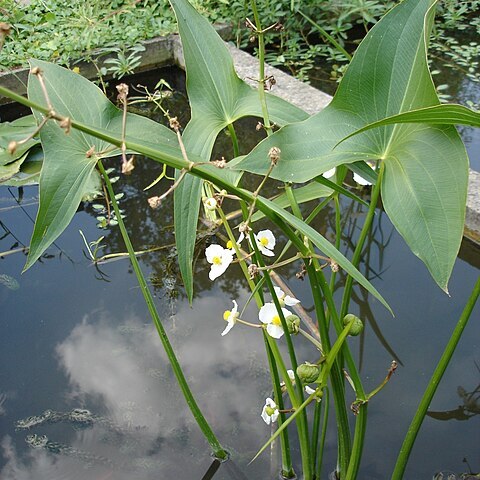Herbs, annual or perennial, rhizomatous, stoloniferous, or cormose, caulescent, glabrous to stellate-pubescent; sap milky. Roots septate or not septate. Leaves basal, submersed, floating, or emersed, sessile or petiolate, sheathing proximally; blade with translucent markings of dots or lines present or absent, basal lobes present or absent; venation reticulate, primary veins parallel from base of blade to apex, secondary veins reticulate. Inflorescences scapose racemes or panicles, rarely umbels, erect, rarely floating or decumbent, whorled (forming racemes) or whorls branching (forming panicles), bracteolate. Flowers bisexual or unisexual, if unisexual, staminate and pistillate on same or different plants, hypogynous, subsessile to long-pedicellate; sepals persistent, 3; petals deciduous, 3, delicate; stamens 0, 6, 9, or to 30, distinct; anthers 2-loculed, dehiscing longitudinally; pistils 0 or 6--1500 or more, distinct or coherent proximally, 1-loculed; placentation basal; ovules1--2. Fruits achenes or follicles. Seeds: embryo U-shaped; endosperm absent in mature seed.
Perennial, rarely annual, aquatic, swamp or marsh herbs, lactiferous. Rhizome very short; roots short, fibrous. Leaves erect, rarely floating or submerged, basal; petiole with an expanded, sheathing base; leaf-blade entire, linear-lanceolate to ovate, with a decurrent to sagittate base, acute to rounded apex. Inflorescence compound or simple, of whorls of branches or flowers, rarely pseudo-umbellate or with solitary flowers; bracts 2 or 3 at the base of each whorl, and sometimes several bracteoles. Flowers regular, bisexual or unisexual. Sepals 3, persistent, herbaceous. Petals 3, deciduous, rarely 0. Stamens 3, 6, 9 or more; filaments filiform or flattened; anthers 2-celled, dehiscing longitudinally and laterally. Carpels superior, free or joined at the base, 3–?, in a whorl or spiral, unilocular; style terminal or ventral; ovules 1, 2 or many, basal and erect, or situated on the ventral suture. Fruit indehiscent. Seeds oblong, indented laterally to follow the form of the horseshoe-shaped embryo, smooth, wrinkled or ridged, without endosperm
Herbs, perennial or rarely annual, aquatic or of marshes, sometimes rhizomatous. Leaves basal, linear, lanceolate, elliptic to ovate or orbicular, or sagittate, with elongated sheathing petioles; principal veins parallel with margins and converging toward apex and connected by transverse veins. Flowers often whorled at nodes of scape forming racemes, panicles, or umbels, pedicellate, actinomorphic, bisexual, unisexual, or polygamous, usually bracteate. Sepals 3, persistent, green. Petals 3, deciduous, usually white, sometimes yellowish. Stamens 3 to numerous, whorled, with elongated filaments; anthers 2-celled, extrorse, opening by longitudinal slits. Carpels 3 to numerous, whorled or spirally arranged, free; ovules 1 to several; style persistent. Fruit a cluster or whorl of laterally compressed achenes, drupelets, or occasionally follicles. Seeds curved, with a horseshoe-shaped embryo; endosperm absent.
Perennial or annual marsh or aquatic herbs, erect, or rarely with floating leaves; leaves basal, with elongated petioles sheathing but open at the base and linear-lanceolate to ovate-rounded often sagittate blades, the principal nerves parallel with the margins and converging at the apex of the blade, the transverse nerves often close and parallel
Carpels free or rarely united at the base, sometimes in a single whorl; style persistent; ovules solitary or several, basal or on the inner angle
Perianth 2-seriate, the outer 3 imbricate, persistent, green and sepal-like, the inner 3 petaloid, imbricate and deciduous or rarely absent
Flowers often whorled, racemose or paniculate, bisexual or rarely polygamous, actinomorphic
Stamens hypogynous, 6 or more, rarely 3, free; anthers 2-locular, extrorse
Fruit a bunch or whorl of achenes, rarely dehiscing at the base
Seeds curved, with horseshoe-shaped embryo; endosperm none
Torus flat to globose

